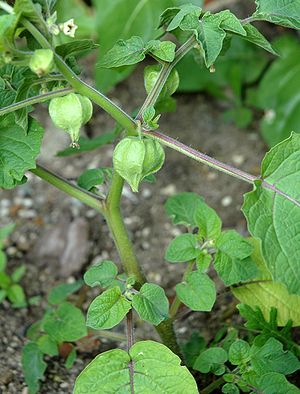Physalis pruinosa
| Physalis pruinosa | ||||||||||||
|---|---|---|---|---|---|---|---|---|---|---|---|---|

Physalis pruinosa |
||||||||||||
| Systematics | ||||||||||||
|
||||||||||||
| Scientific name | ||||||||||||
| Physalis pruinosa | ||||||||||||
| L. |
Physalis pruinosa also Ananaskirsche is a plant from the genus of jujubes ( Physalis ) in the family of the nightshade family (Solanaceae).
description
Vegetative characteristics
Physalis pruinosa is an annual , herbaceous plant that reaches heights of between 20 and 140 cm. The stems are covered with long (2.0 to 2.5 mm) and short (0.5 to 1.0 mm) multicellular, glandular trichomes .
The leaves have a length of 3.5 to 16.5 cm and are densely tomentose with multicellular glandular trichomes. The leaf stalks are 1.0 to 6.5 cm long. The leaf blades have a length of 2.5 to 12.0 cm and a width of 2 to 9 cm, they are egg-shaped to elliptical, the tip is pointed to pointed, the base is heart-shaped or cut off, occasionally also crooked and then with up to 1 cm staggered halves. The leaf margin is serrated or, rarely, entire.
blossoms
The flower stalks are 1.7 to 3.0 cm long. The hermaphroditic flowers are radial symmetry and five-fold with a double flower envelope . The calyx is long, tomentose and, including the pointed calyx tips, 2.5 to 6.0 mm long and 1.0 to 1.5 mm wide. The yellow crown has a diameter of 1.0 to 1.5 cm, the individual petals are marked with five brown spots that have little contrast to the rest of the petals. The inside of the crown can be hairy or hairless. The stamens are blue, the anthers are yellow and 2.0 to 3.5 mm long.
Fruits and seeds
When the fruit ripens, the calyx expands to a length of 3.5 to 6.0 cm and a width of 2.5 to 4.0 cm. But it is always longer than it is wide. The cross section of the calyx is clearly five-angled, the surface is glandular-hairy. The stem does not thicken and is about 0.5 mm wide and 3.0 to 5.5 cm long. The fruit is a spherical, dark brown, sticky berry with a diameter of 1.0 to 2.5 cm. It contains a large number of brown seeds with a finely pitted surface and a diameter of 2 mm.
Chromosome number
The number of chromosomes is 2n = 24.
Phenology
From Mexico to Central America, Physalis pruinosa flowers from July to August, and ripe fruits were found between January and March. In South America, Physalis pruinosa flowers from January to May.
Occurrence
The distribution area of Physalis pruinosa extends from the Mexican state Chihuahua across Central America , with the exception of Panama and El Salvador to southern Argentina . Physalis pruinosa grows at altitudes of up to 1400 m and colonizes moist, mountainous oak forests or often dry, deciduous forests.
Systematics
The first publication of Physalis pruinosa was done by Carl von Linné .
The species Physalis pruinosa belongs to the Epeteiorhiza section in the subgenus Rydbergis within the genus of the bladder cherries ( Physalis ). Physalis pruinosa is similar to Physalis nicandroides . The two species are often confused, especially when the stems become bald with age. Physalis pruinosa can, however, be distinguished by the non-thickening fruit stalks.
use
The fruit of Physalis pruinosa is used as food in Mexico.
literature
- Mahinda Martinez: Revision of Physalis Section Epeteiorhiza (Solanaceae). In: Anales del Instituto de Biología Universidad Nacional Autónoma de México , Series Botánica, Volume 69, No. 2, 1998. pp. 71-117.
Individual evidence
- ↑ Jan Dönges: Will the pineapple cherry become the new strawberry? Spektrum.de , October 2, 2018, accessed on October 3, 2018 .
- ↑ Physalis pruinosa at Tropicos.org. In: IPCN Chromosome Reports . Missouri Botanical Garden, St. Louis